| Author |
Message |
domwild
Guru

Joined: 16/12/2005
Location: AustraliaPosts: 873 |
| Posted: 11:32pm 15 Mar 2010 |
 Copy link to clipboard Copy link to clipboard |
 Print this post |
|
Hi,
Switching on my UPS means closing the blade switch to the battery and only then switching on the mains. I have been told to do it the other way around will blow the UPS.
Switching the battery in is frightening enough and makes me wonder if I can do that repeatedly without smoke escaping.
Why would the UPS blow if mains are switched in first followed by the battery?
*
Taxation as a means of achieving prosperity is like a man standing inside a bucket trying to lift himself up.
Winston Churchill |
| |
GWatPE
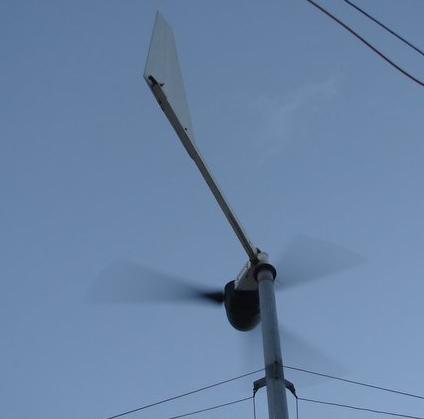
Senior Member

Joined: 01/09/2006
Location: AustraliaPosts: 2127 |
| Posted: 03:04am 16 Mar 2010 |
 Copy link to clipboard Copy link to clipboard |
 Print this post |
|
Hi Dom,
the UPS electronics needs a stable DC supply. There may be battery recharging circuitry that attempts to fill the main 50Hz bypass caps, that is a poor substitute for a battery. There will be AC ripple, that would probably confuse the UPS. Better to provide the right battery. UPS become problamatic as the battery ages, and I had a UPS die when the battery dryed out. Was OK until that point, so no battery, no go.
Gordon.
become more energy aware |
| |
domwild
Guru

Joined: 16/12/2005
Location: AustraliaPosts: 873 |
| Posted: 10:39am 17 Mar 2010 |
 Copy link to clipboard Copy link to clipboard |
 Print this post |
|
Thanks, Gordon.
Taxation as a means of achieving prosperity is like a man standing inside a bucket trying to lift himself up.
Winston Churchill |
| |
sPuDd

Senior Member

Joined: 10/07/2007
Location: AustraliaPosts: 251 |
| Posted: 10:20pm 17 Mar 2010 |
 Copy link to clipboard Copy link to clipboard |
 Print this post |
|
Dom,
you could fit another switch across the knife switch
in series with a suitable light bulb. This will allow
you to bleed current into the UPS until the bulb goes
dim, then engage the knife switch without a bang.
sPuDd..
It should work ...in theory |
| |
domwild
Guru

Joined: 16/12/2005
Location: AustraliaPosts: 873 |
| Posted: 02:03am 18 Mar 2010 |
 Copy link to clipboard Copy link to clipboard |
 Print this post |
|
spud,
Thanks for that. Just to make matters worse, this is a 36V UPS! I have a 8000 MFD (?) 175 VDC cap. Will that do?
Taxation as a means of achieving prosperity is like a man standing inside a bucket trying to lift himself up.
Winston Churchill |
| |
sPuDd

Senior Member

Joined: 10/07/2007
Location: AustraliaPosts: 251 |
| Posted: 10:52pm 19 Mar 2010 |
 Copy link to clipboard Copy link to clipboard |
 Print this post |
|
I don't know what the cap reference is for.
A 36Vdc UPS & battery bank would be happy with 4x 12V car bulbs in series. A picture is worth a thousand words:
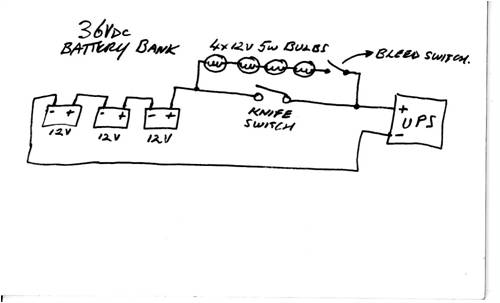
sPuDd..
It should work ...in theory |
| |
SSW_squall

Senior Member

Joined: 20/03/2010
Location: AustraliaPosts: 111 |
| Posted: 01:42am 20 Mar 2010 |
 Copy link to clipboard Copy link to clipboard |
 Print this post |
|
I should have joined this awesome forum ages ago!!
Speaking of UPS's
At work we have quite afew APC smart UPS's and the batteries would seem die after quite a short time - 18 months given we have about 2-3 power cuts a year.
The reason - the heat from the ups's internal transformer & electronics means that the battery is subjected to temps of approx 35-40 deg.
On our generation of APC units the float voltage IS NOT temperature compenstated and remains at 13.8 V so, over time the battery gets overcharged and boiled dry!!
Only very recently has APC introduced temp compensated battery charging, and only on the larger server style smart UPS's...
The solution: Connect the batteries externally.
The other gripe: the internal batteries are just TOO SMALL to supply any sort power close to the units rating
How can 2x pissy 7Ah batteries supply 400W?? it's just a joke 
Our main server has 2x (24v) 40Ah AGM batteries connected to a 1500VA smart UPS, the power useage is 300-400w so it should last at least 2h
ETSA has scheduled a power outage from 1-3AM on the 7/4/2010 to connect the new substation thats being built round the corner. So we'll see how it goes then...
Andrew
Einstein: Everything should be made as simple as possible, but not one bit simpler |
| |
domwild
Guru

Joined: 16/12/2005
Location: AustraliaPosts: 873 |
| Posted: 02:01am 26 Mar 2010 |
 Copy link to clipboard Copy link to clipboard |
 Print this post |
|
Spud,
The cap reference is in relation to allowing the storage of current as suggested in an earlier mail.
Taxation as a means of achieving prosperity is like a man standing inside a bucket trying to lift himself up.
Winston Churchill |
| |
domwild
Guru

Joined: 16/12/2005
Location: AustraliaPosts: 873 |
| Posted: 02:04am 26 Mar 2010 |
 Copy link to clipboard Copy link to clipboard |
 Print this post |
|
Andrew,
Thanks for the warning re temperature.
Taxation as a means of achieving prosperity is like a man standing inside a bucket trying to lift himself up.
Winston Churchill |
| |
SSW_squall

Senior Member

Joined: 20/03/2010
Location: AustraliaPosts: 111 |
| Posted: 01:23pm 26 Mar 2010 |
 Copy link to clipboard Copy link to clipboard |
 Print this post |
|
No worries...
All UPS's have an internal bypass capacitor
(generally 1000uF or more)to help keep the supply impedance low.
So when you connect the battery to the UPS theres a nice juicy spark as the cap charges up. Nothing to worry about really...
Actually UPS make quite good inverters:
We've had a couple of the desktop APC unit fail in such a way that the battery charging part of the UPS stops working but the inverter bit still works fine...
So i've extended the battery leads, chucked an 80mm PC fan on the side of the case to keep it cool and i have 200w of power on tap where ever there is 12v available!!
These small UPS's have a square wave output, but it can still power heaps of stuff: incandesacent lights, CFL's phone chargers, laptop's ect
Used it when we went camping on kangaroo island earier this year, (used the car battery as 12v power)
Even used it to run a small cheast freezer when the wife's uncle moved house and the twits at ETSA couldn't put the power on for a day or two...
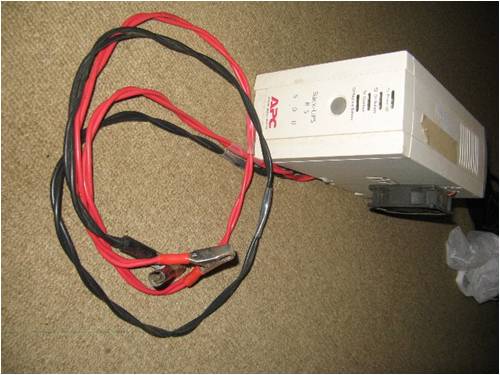
I have a 48V 2.2KVA UPS that will form part of the main RE system at home:
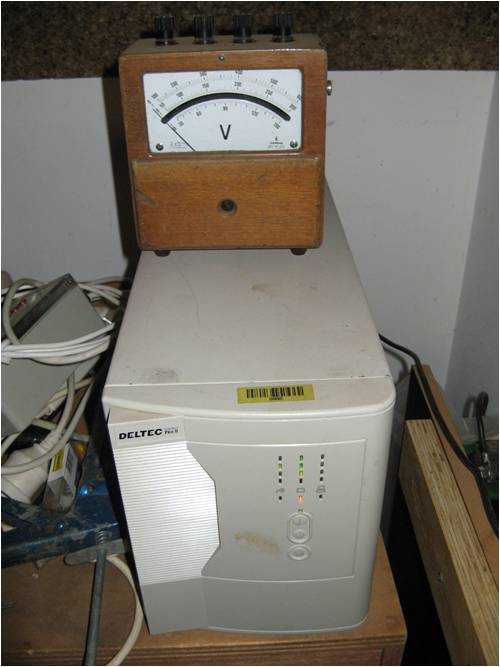
The power that comes out of it is more sinusoidal than what comes out of the grid.
It will easily start and run our 1HP induction motor water pumps, run the washing machine, breezeair evaporative A/C, fridge
Down side is it does use about 30W (720Wh/day) with no AC loads connected. but i'm planning to replace some of the linear regs 7824, 7812 inside the unit to get this down abit.
I have it hooked up to a 48V 620Ah battery bank that i got 2nd hand from the electric forklift at work.
The bottle at the end of the bank is just water, NOT sulfuric acid
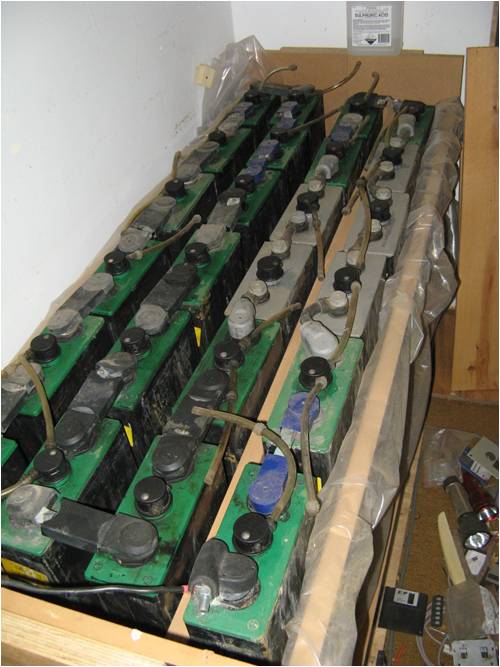
Just waiting till winter so i can get a F&P smart drive micro hydro generator running and actually make the whole rig work to offset our grid useage

Einstein: Everything should be made as simple as possible, but not one bit simpler |
| |
brucedownunder2
Guru

Joined: 14/09/2005
Location: AustraliaPosts: 1548 |
| Posted: 09:55pm 26 Mar 2010 |
 Copy link to clipboard Copy link to clipboard |
 Print this post |
|
Hi Andrew and Crew...
I've had 24v and 48v and 96v ups's.. for years
The 24v apc's have been working every day for 10 years with not one problem..
one of the 48v er's blew a cap ,so I replaced that and it's fine.
They do use a fair bit of stand-by power, but I don't mind ,they were all free.
I've noticed the 48v ones don't like the batteries to discharge ,when there is no wind or sunlight .So I have 3 different battery banks (because they are different types oof batteries), and so ,I just turn the big rotary switch to another bank when the ups indicates low battery.
they start my frig,,but struggle to turn on the heat gun when I'm heatshrinking. Also don't like my 600 watt electric drill,even though they are 1200 watt ups's.
I'm using 16mm multistrand cables , say around 3 mtrs. maybe I should go to 25-35 mm square ??
The apc 1200's have no fan and have never suffered any heat problems, but one day I'll install a 4inch fan ,either 240v or 24v.
Bruce
Bushboy |
| |
domwild
Guru

Joined: 16/12/2005
Location: AustraliaPosts: 873 |
| Posted: 01:38am 29 Mar 2010 |
 Copy link to clipboard Copy link to clipboard |
 Print this post |
|
Squall,
Those batteries look like 2V lead/acids and may not be SLAs. If so, I noticed the charging voltage of any UPS would be lower or too low for lead/acids as they normally meant to charge SLAs and SLAs appear to get charged to a lower voltage.
How did you get around that problem or is it not a problem anyway, as the batts are really SLAs??
Taxation as a means of achieving prosperity is like a man standing inside a bucket trying to lift himself up.
Winston Churchill |
| |
SSW_squall

Senior Member

Joined: 20/03/2010
Location: AustraliaPosts: 111 |
| Posted: 01:48pm 29 Mar 2010 |
 Copy link to clipboard Copy link to clipboard |
 Print this post |
|
HI Dom,
The batteries i have are the flooded or wet cell type, not SLA's. As you may be able to see in the photo there is plastic sheeting under and around the bank to preavent any acid spills from damaging anything.
At the moment the UPS keeps the battery on float at approx 55.4v with out any problems (13.85v refered to 12v battery).
This is a normal float voltage for both SLA and wet cell types at nominal temp of 20deg C.
The battery bank is inside downstairs such that the temperature is more stable, as batteries perform best when kept at a stable temperature.
I have a rectifier/filter caps that i can connect to my GMC stick welder to push 10A or more into the bank.
This allows the voltage to be increased to 57.6v (14.4v refered to a 12v batery) absorb voltage or even higher 60v which is the equalization level.
The bank really starts fizz at these voltages, not a bad thing to do once in a while: de stratifies the acid, reduces suphation...
As an aside the car battery in my father inlaw's Hilux failed after only 2 years.
Measured the charge voltage: 14.1v !!
WAY TOO HIGH for average Australia temps of 35 degrees
The battery was getting overcharged at this voltage and failed due to plate corrosion.
Although 2nd hand it seems the battery is in reasonable nick, i had it delivering 800w to the rain water transfer pump for over an hour and the voltage only? got down to about 49.5V.
AB
Einstein: Everything should be made as simple as possible, but not one bit simpler |
| |
domwild
Guru

Joined: 16/12/2005
Location: AustraliaPosts: 873 |
| Posted: 11:59pm 29 Mar 2010 |
 Copy link to clipboard Copy link to clipboard |
 Print this post |
|
Andrew,
Thanks for that. Re Hilux: I measured 12.7V at rest and 14.33V charging voltage after starting on my Mitsubishi petrol van. Is this too high?
Taxation as a means of achieving prosperity is like a man standing inside a bucket trying to lift himself up.
Winston Churchill |
| |
SSW_squall

Senior Member

Joined: 20/03/2010
Location: AustraliaPosts: 111 |
| Posted: 07:36am 30 Mar 2010 |
 Copy link to clipboard Copy link to clipboard |
 Print this post |
|
Maybe...
The voltage regulator on the alternator SHOULD be temperature compensated:
When cold the alternator might put out 14.4 volts, but as everything in the engine bay warms up the the voltage should come down to less than 14v.
The alternator in our Mitsubishi NH Pajero works in this way..
When i checked the Hilux, the engine was definetly hot, so hence my concern.
Most alternators on cars from the 90's onwards also have a voltage sense wire that is connected to a strategic point somewhere near the battery. Such that the alternator can control the voltage at the battery more accurately.
This can cause issues this the sense wire is loose or faulty.
For most lead acid batteries the temp coefficient is about -20mV/degC so deduct 0.1v every 5 additional degrees.
Or add 0.1v for every 5 deg fall in temp.
So it does depend...
But if your driving around and the outside temp is 35deg and the alternator is delivering over 14v then your battery will be overcharged, with requisite reduction in it's life span.
Car batteries have a hard life being subjected to large temperature variations, which can't really be compensated for easily and in any case don't help the battery's cause.
Which is why on the new Commodores the battery is mounted in the boot area. Also new alternators are connected to the CAN bus so the engine ECU can control it's output. I read somewhere that the new Commodore actually uses power from the battery when the engine is running as part of the strategy to reduce fuel consumption...
I just hope that the engineers who came up with THAT system, made it a "fail safe" one 
AB
Einstein: Everything should be made as simple as possible, but not one bit simpler |
| |
SSW_squall

Senior Member

Joined: 20/03/2010
Location: AustraliaPosts: 111 |
| Posted: 02:20pm 07 Apr 2010 |
 Copy link to clipboard Copy link to clipboard |
 Print this post |
|
ETSA has scheduled a power outage from 12-3AM on the 7/4/2010 to connect the new substation thats being built round the corner. So we'll see how it goes then...
UPDATE:
The UPS batteries kept the server up for abit over 1 hour, which is not too bad?? But shut down due to low runtime remaining, NOT due to low battery signal.
I think the stupid runtime meter is still out of calibration by a bit, even through i reset the battery constant manually back to factory value.
I was hoping for about 2 hours, given the batery is 40Ah 24V = 960Wh supporting a 400w load
I think i'll manually doctor the runtime so that it' set to some very large number
Anyway the power came back on a about 3AM so it probably wouldn't have quite lasted the distance anyway. Which does make me feel abit better...
AB
Einstein: Everything should be made as simple as possible, but not one bit simpler |
| |
GWatPE

Senior Member

Joined: 01/09/2006
Location: AustraliaPosts: 2127 |
| Posted: 11:07pm 07 Apr 2010 |
 Copy link to clipboard Copy link to clipboard |
 Print this post |
|
Hi AB,
battery sizing is a bit of smoke and mirrors. To calculate the stored capacity, by multiplying the Ah x the voltage is like kVA on a genset, giving large numbers that a salesman would find useful.
The battery will not give this power. You would not normally drain the battery to 0Ah left, as it will have a very short life, without careful recharging, which the UPS will not have.
The Lead-Acid battery [typical] in an RE system would not normally be discharged to below the rated system voltage. The battery has approx 50% marked capacity at this voltage, when new, and the useful capacity will normally be less than this.
Gordon.
become more energy aware |
| |
SSW_squall

Senior Member

Joined: 20/03/2010
Location: AustraliaPosts: 111 |
| Posted: 11:29am 08 Apr 2010 |
 Copy link to clipboard Copy link to clipboard |
 Print this post |
|
HI Gordon,
I agree with your comments, there is no way that 960Wh is going to come out of the batteries. Especially not at that high rate of discharge we are talking about.
However i would not object to having the batery discharge reasonably deeply in this application given we only have less than 5 power cuts of any significant length in a year.
When in "dumb" mode (no monitoring PC connected) the UPS shuts down when it detects low battery, approx 22v.
But in smart mode, it's almost too smart for it's own good as it tries to estimate the runtime which is generally not that accurate in my experience.
Intially the runtime meter was only showing 5 minutes because the battery constant had not been reset. Because we'd set the time for the server to shut down to 10 minutes, the UPS monitoring software was warning of insufficent runtime available.
The end result was that the UPS shut down straight away, when the power failed!!
The APC units do treat the battery charging reasonable well: the bulk stage is current limited to about 6 amps, then the battery gets held at the float voltage as the current decreases untill it eventually attains full charge.
There is no absorb stage but, that's not the end of the world...
By opening up a hyperterminal session with the UPS over the RS232 serial connection. It's possible to change various parameters on the UPS manually, that are not accessible from the powerchute software.
There's quite abit of info on these serial commands for the APC and other UPS's online.
AB
Einstein: Everything should be made as simple as possible, but not one bit simpler |
| |
GWatPE

Senior Member

Joined: 01/09/2006
Location: AustraliaPosts: 2127 |
| Posted: 12:55pm 09 Apr 2010 |
 Copy link to clipboard Copy link to clipboard |
 Print this post |
|
the lack of a battery maintenance reigime, as indicated by your explanation of how these APC units recharge the battery is a good indication of why so many suffer battery failure. What you describe is a current limited voltage regulated supply, and this will result in a reduction of battery capacity, each tiome the battery is discharged. This includes mini cycles. The standby current of UPS's, for their capacity negates them from typical RE use. As a mains operated appliance they consume approx 15-20W. This is approx 0.4kWhr/day. In an RE system, this is approx the power from an 75W solar panel, and this is before any useful work is done.
I have 2 UPS, not connected, and no battery installed, just an anderson connector that can connect to my main battery. These are purely spares, in case my real inverter needs service.
BTW compare the power in standby of an RE inverter of 50mA @ 24V, to the 15-20W of a typical UPS, that cannot offer a standby feature.
Gordon.
PS edit:
For a little suport to my comments above, this should help.
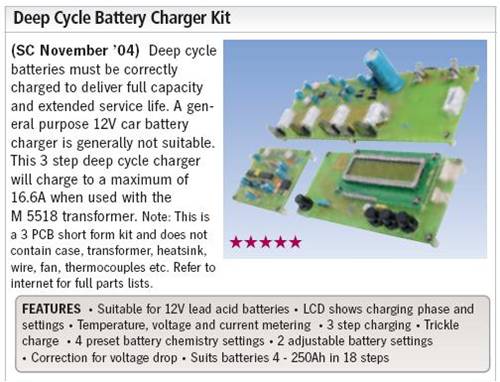
The charging reigime in the UPS, is a single step system, with current limiting, to avoid burning itself out.
Edited by GWatPE 2010-04-11
become more energy aware |
| |

